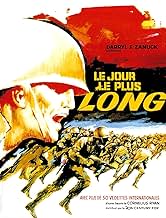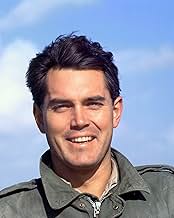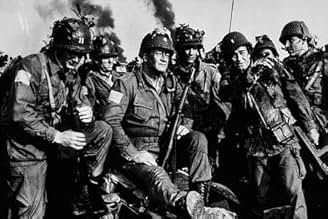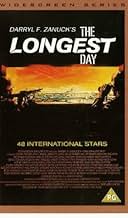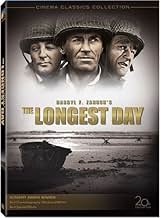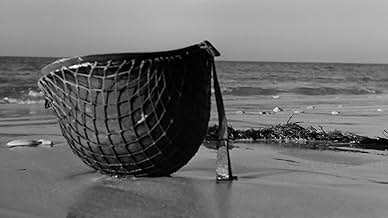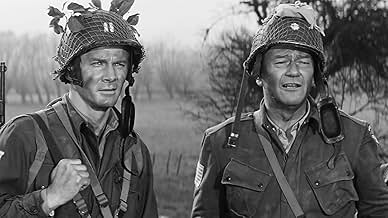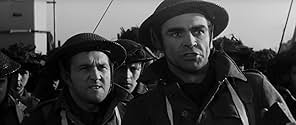VALUTAZIONE IMDb
7,7/10
60.646
LA TUA VALUTAZIONE
Lo sbarco in Normandia raccontato dal punto di vista degli Alleati e da quello dei tedeschi.Lo sbarco in Normandia raccontato dal punto di vista degli Alleati e da quello dei tedeschi.Lo sbarco in Normandia raccontato dal punto di vista degli Alleati e da quello dei tedeschi.
- Vincitore di 2 Oscar
- 8 vittorie e 6 candidature totali
Irina Demick
- Janine Boitard
- (as Irina Demich)
Trama
Lo sapevi?
- QuizWhile clearing a section of the Normandy beach near Pointe du Hoc, the crew unearthed a tank that had been buried in the sand since the original invasion. Mechanics cleaned it off, fixed it up and it was used in the movie as part of the British tank regiment.
- BlooperThe American paratroopers are incorrectly shown jumping with a jumpmaster standing in the plane and commanding them to "Go!" "Go!" one at a time. On D-Day, as on all combat jumps, the jumpmaster was always first out the door, with the rest of the paratroopers following immediately behind him, exiting the plane as fast as they could in order to land as close together as possible.
- Citazioni
Flight Officer David Campbell: The thing that's always worried me about being one of the few is the way we keep on getting fewer.
- Curiosità sui creditiThere is a 20-second overture on a black screen, no 20th Century Fox logo (in spite of this being one of their most expensive productions), and a six-minute cold open before the title is displayed. Apart from the title, there are no credits at the beginning of the film. All cast and crew credits are at the end of the film.
- Versioni alternativeSome video copies omits Jean Servais scenes as a Free French admiral making a short speech to his crew before the shore bombardments starts.
- ConnessioniEdited into All This and World War II (1976)
Recensione in evidenza
This an important, interesting movie depicting the Overlord operation with monumental logistic and means of effecting the Normandy landing , the most difficult campaign of war . The picture brings to life the famous images of WWII and splendidly the most sensational military operation of the history in an Allied hard-fought effort . The film develops the previous days to the D-Day invasion , such as the landings and the advance over France . The film is magnificently produced in big budget by the great 20th Century Fox producer Darryl F. Zanuck . Evocative cinematography by Jean Bourgoun and catching song by Paul Anka with musical score by Maurice Jarre . Excellent casting by a great plethora of stars . Special mention for John Wayne as Lt. Colonel Benjamin Vandervoort , he's top-notch as a tough , valiant officer in this believable war film and terrific acting by Richard Todd as Major commanding Us paratroopers dropped to protect the flanks of the invasion and taking strategic bridge . Furthermore , known Generals and officers played by prestigious players , as Germans : General Gunther (Curt Jurgens) , Field Marshal Erwin Rommel (Hinz) , Field Marshal Von Rundstedt (Paul Hartmann), and Allied : Brig. General Theodore Roosevelt Jr (Henry Fonda) , Brig. General Norman Cota (Robert Mitchum) , General Haines (Mel Ferrer) , Brig. General James Gavin (Robert Ryan) , General Raymond Barton (Edmond O'Brien), Lt General OMar N Bradley (Stuart) , General Bernard L Montgomery (T. Reid) and General Dwight D. Eisenhower played by Henry Grace . Grace was a famed set designer , while he worked extensively for many films , his only appearance was an uncredited performance as Eisenhower ; despite not being an actor , he was cast for his uncanny resemblance to the General . This famous event from how was orchestrated the dangerous , risky landing maneuvers was professionally directed by a magnificent trio of directors , Ken Annakin , Bernhard Wicki and Andrew Marton.
Adding more details along with the well developed on the movie , the events that happened on June 6, 1944 were the following ones : Shortly after midnight on June 6, about 23.500 US and British paratroopers landed along the edges of the landing beaches . Their mission was to seize vital bridges and communications centers. They also had to hold off any Germans counterattacks until they were relieved by the amphibious forces. The Airbone landings were largely successful. Some US troops missed their target and end up scattered over the countryside. The main amphibious landings took place after an artillery bombardment from some 200 Allied warships at German positions also came under attack from Allied medium and heavy bombers. They were part of the 11,500 aircraft committed to D-Day. They bombed the Germans on and behind the five landing beaches. US troops landed on Utah beach. Strong currents and inaccurate navigation meant that they were a little away from their precise target. They landed about 1 mile (1,6 km) south. The beach there was relatively undefended. The troops soon knocked out the only concrete gun position guarding the beach.Demolitions teams cleared paths through the obstacles the beach and the first tanks crossed the Atlantic Wall. They fanned out into the countryside to link up with the paratroopers. By nightfall of D-Day some 23,000 men and 1,700 vehicles had gone ashore. The beach had been highly congested for much of the day. Utah was a triumph ,however Omaha beach was nearly a disaster, the fight was the most difficult. The Us troops were unable to get off the beach to make room for later waves of invaders. There were better defenses there than on the other beaches, and the German defenders were positioned on high ground, from where they could pour fire down on the attackers.The allies also made mistakes. The naval bombardment ended too soon, and the bombers missed their targets and launched landing crafts and amphibious tanks too far out from the beach, may were sunk. When the first assault wave landed ,it faced a bar-rage of fire , some men were thinking of evacuation. However small groups began to make it off the beach to the high ground beyond. By dusk, some men were ashore, most were still crowed on the beach. The high ground beyond was only thinly held by exhausted survivors waves. Some 2300 US troops had been killed in the landings. The operation had come close to disaster. The three Anglo-Canadian beaches-Gold, Sword and Juno stretched fore some 25 miles. They were wide and open and ideal for amphibious landings. The British on Gold and Sword quickly crashed though the Atlantic wall. Their success was due partly to a range of specially developed armored vehicles known as Funnies. The Canadians at Juno had a tougher time. They faced rough seas and alert defenders .By late morning ,they were also pushing inland. Despite the horror of beaches , overall Allied losses were far lower than expected. Some 6000 US personnel were killed, wounded, or missing, along with 4300 British and Canadian troops. German losses totaled between 4000 and 8000. By the day's end ,some 128000 Allied soldiers were ashore and many more were on their way.
Adding more details along with the well developed on the movie , the events that happened on June 6, 1944 were the following ones : Shortly after midnight on June 6, about 23.500 US and British paratroopers landed along the edges of the landing beaches . Their mission was to seize vital bridges and communications centers. They also had to hold off any Germans counterattacks until they were relieved by the amphibious forces. The Airbone landings were largely successful. Some US troops missed their target and end up scattered over the countryside. The main amphibious landings took place after an artillery bombardment from some 200 Allied warships at German positions also came under attack from Allied medium and heavy bombers. They were part of the 11,500 aircraft committed to D-Day. They bombed the Germans on and behind the five landing beaches. US troops landed on Utah beach. Strong currents and inaccurate navigation meant that they were a little away from their precise target. They landed about 1 mile (1,6 km) south. The beach there was relatively undefended. The troops soon knocked out the only concrete gun position guarding the beach.Demolitions teams cleared paths through the obstacles the beach and the first tanks crossed the Atlantic Wall. They fanned out into the countryside to link up with the paratroopers. By nightfall of D-Day some 23,000 men and 1,700 vehicles had gone ashore. The beach had been highly congested for much of the day. Utah was a triumph ,however Omaha beach was nearly a disaster, the fight was the most difficult. The Us troops were unable to get off the beach to make room for later waves of invaders. There were better defenses there than on the other beaches, and the German defenders were positioned on high ground, from where they could pour fire down on the attackers.The allies also made mistakes. The naval bombardment ended too soon, and the bombers missed their targets and launched landing crafts and amphibious tanks too far out from the beach, may were sunk. When the first assault wave landed ,it faced a bar-rage of fire , some men were thinking of evacuation. However small groups began to make it off the beach to the high ground beyond. By dusk, some men were ashore, most were still crowed on the beach. The high ground beyond was only thinly held by exhausted survivors waves. Some 2300 US troops had been killed in the landings. The operation had come close to disaster. The three Anglo-Canadian beaches-Gold, Sword and Juno stretched fore some 25 miles. They were wide and open and ideal for amphibious landings. The British on Gold and Sword quickly crashed though the Atlantic wall. Their success was due partly to a range of specially developed armored vehicles known as Funnies. The Canadians at Juno had a tougher time. They faced rough seas and alert defenders .By late morning ,they were also pushing inland. Despite the horror of beaches , overall Allied losses were far lower than expected. Some 6000 US personnel were killed, wounded, or missing, along with 4300 British and Canadian troops. German losses totaled between 4000 and 8000. By the day's end ,some 128000 Allied soldiers were ashore and many more were on their way.
I più visti
Accedi per valutare e creare un elenco di titoli salvati per ottenere consigli personalizzati
Dettagli
- Data di uscita
- Paese di origine
- Sito ufficiale
- Lingue
- Celebre anche come
- The Longest Day
- Luoghi delle riprese
- Sainte-Mère-Eglise, Manche, Francia(parachutists landing in the village)
- Azienda produttrice
- Vedi altri crediti dell’azienda su IMDbPro
Botteghino
- Budget
- 10.000.000 USD (previsto)
- Tempo di esecuzione2 ore 58 minuti
- Colore
- Proporzioni
- 2.35 : 1
Contribuisci a questa pagina
Suggerisci una modifica o aggiungi i contenuti mancanti

Divario superiore
What was the official certification given to Il giorno più lungo (1962) in Mexico?
Rispondi

